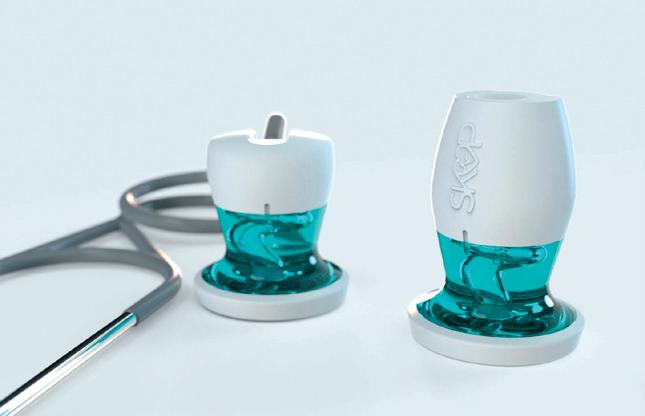
5 minute read
Sterilization: EtO go home
from MPN NA Issue 18
by MPN Magazine
AS A STERILIZING AGENT, ETHYLENE OXIDE’S DAYS ARE NUMBERED, AS THE MEDICAL DEVICES INDUSTRY LOOKS SET TO EMBRACE ALTERNATIVE STERILIZING AGENTS SUCH AS CHLORINE DIOXIDE, SAYS EMILY LORCHEIM, PROJECT MANAGER, CLORDISYS SOLUTIONS, INC.
ET0
Go Home
Medical device sterilization has seen few advancements compared with most other industries. Even as ethylene oxide (EtO) faces increasing pressure due to potential environmental health hazards, its market share has held steady since the mid-1990s. Much of this is due to the lack of a clear industry standard to innovate and accept new technologies, prolonging the potentially dangerous status quo. Recent events, however, have shown chlorine dioxide (CD) gas to offer promise as a viable low temperature sterilization method, and the first commercially available medical device product sterilized with CD gas has just hit the US market.1
ETO ISSUES In 2006, and after reviewing studies by the National Institute of Occupational Safety and Health (NIOSH) studies, the Environmental Protection Agency (EPA) released a draft of its review of EtO and determined it is a human carcinogen (as published in its Final Report).² In 2018, the EPA released its latest National Air Toxics Assessment based on industry supplied emissions data from 2014.³ The report showed that 109 of the 73,057 census tracts within the US faced cancer risks due to exceeding EtO emission levels according to EPA guidelines.
One area with very high EtO levels was Willowbrook, IL. Illinois Attorney General and the County Attorney General sued the main sterilization company who performs EtO services on medical devices within the city.⁴ Despite attempts to add extra pollution control measures, the city of Willowbrook experienced exceedingly high EtO levels in the air for nearly a year. In February 2019, the Governor ultimately decided to ban the sterilization firm from using EtO at the plant. A legal settlement eventually allowed the company to resume operations in Willowbrook once they installed new equipment to reduce EtO emissions.
ADDRESSING THE ROADBLOCKS TO INNOVATION One reason why the use of EtO was allowed to continue was the lack of a suitable alternate method. Guidance existed for the use of established medical device
sterilization methods in the form of ISO standards and guidance documents from the Association for the Advancement of Medical Instrumentation (AAMI). There was no roadmap on how to implement and validate alternate sterilization methods. Limiting the use of EtO was deemed a risk to the global medical device supply chain, as shortages to these essential products could have fatal effects.
To address the situation, the US Food and Drug Administration (FDA) and General Hospital and Personal Use Devices Panel of the Medical Device Advisory Committee met to discuss the topic of industrial EtO sterilization and its impact on public health in November 2019. Alternative methods of sterilization were presented to spur innovation within the industry. One sterilization method presented at the meeting was CD gas.
CHLORINE DIOXIDE GAS CD gas has been recognized and used as a sterilizing agent since the 1980s. As a non-carcinogenic, residue-free sterilizing agent with high material compatibility, it has found many uses across multiple industries. The idea for CD gas to be used a medical device sterilant is not a new one. In fact, its first applications were for the sterilization of artificial joints, suture products, and interocular lenses in the late 1990s.
As a true gas at low temperatures, CD follows gas laws to evenly and completely fill the chamber that it is injected into. Although devices containing embedded batteries cannot be sterilized by EtO, CD gas has been shown to be compatible, as it doesn’t pose the same explosive risk as EtO. With many medical devices becoming even more complex and technical, companies commonly have devices that cannot be autoclaved, irradiated, or treated with EtO due to incompatibilities. This results in CD gas being the only viable solution for device sterilization for many manufacturers and engineers.
Although CD gas can provide sterilization at ambient pressure, use within vacuum pressure chambers allows for the sterilization of complex devices and those within bulk packaging. CD gas also offers a vast reduction in cycle time and complexity of the sterilization process. Items can be loaded into a single sterilization chamber where the entire cycle, including aeration, occurs. Cycle lengths vary depending on each device’s requirements, but typically last from 2 to 8 hours, inclusive of aeration time.
PROGRESSION Furthering the progression away from EtO, the FDA newly approved a contract sterilization facility for medical devices utilizing CD gas in late 2020.1 This breakthrough advancement was awarded to ClorDiSys Solutions. The company was established in 2001, beginning as an adoption of technology the founders originally created within Johnson and Johnson. There, medical devices such as interocular contact lenses, sutures, artificial hip joints and more were sterilized internally using CD gas. This facility recently processed the first commercially sold medical device sterilized with CD gas that has US approval.
A draft Reference File for the use of CD gas has been created, which is developed from ISO and AAMI EtO guidelines. This serves to aid in submission packages to both the FDA and EU regulatory agencies. These tools provide a regulatory roadmap for validating the sterilization process outside of the typical EtO, Gamma irradiation, E-Beam/X-ray, steam, and dryheat methods.
As regulations regarding the use of EtO tighten, the ability to pursue effective alternatives is becoming crucial. CD gas’s increasing prevalence within the market marks the closest process to EtO without the environmental concerns, giving hope to a safer future for medical device sterilization.
REFERENCES 1. ClorDiSys Solutions, Inc, Branchburg, NJ, (Registration #3013115071). 2. US EPA. Evaluation of the Inhalation Carcinogenicity of Ethylene Oxide (Final Report). US Environmental Protection Agency, Washington, DC,
EPA/635/R-16/350F, 2016. 3. https://www.epa.gov/national-air-toxics-assessment/nata-overview 4. https://www.chicagotribune.com/news/ct-sterigenics-eto-timelinehtmlstory.html


Qosina offers a wide selection of stock and custom tubing solutions for medical and bioprocessing applications. Choose from over 100 tubing options available in a variety of brands, types and materials.
Brands Stock Materials
Tygon® C-Flex® SaniPure™ BDF™ PharMed® BPT PharmaFluor® TuFlux® DEHP-free PVC TPE HDPE FEP Platinum- and peroxide-cured silicone Multi-layer
Qosina is a leading global supplier of thousands of stock components to the medical and pharmaceutical industries.
Qosina Corp.:
2002-Q Orville Drive North, Ronkonkoma, NY 11779 USA qosina.com +1 (631) 242-3000 info@qosina.com
Qosina Europe:
Viale Giacomo Matteotti, 26, 20095 - Cusano Milanino (MI) - Italy +39 02 66401337 info@qosinaeurope.com
Dynamic Extrusion for Today’s Medical Industry
Your medical tubing operation deserves precision and profitability. From microbore to multi-lumen, catheter to radio-opque, we’re ready to engineer a versatile, tighttolerance solution for your cleanroom process.
Call +1 860-934-0575 to optimize your medical tubing!











